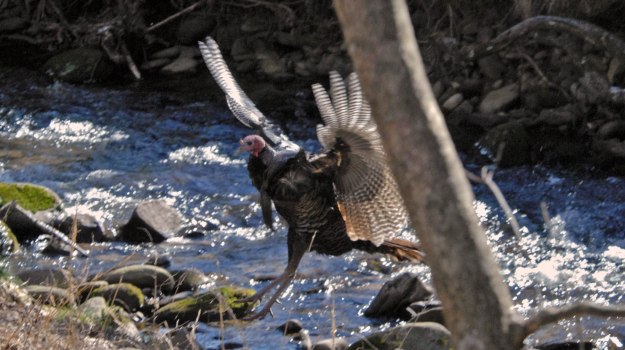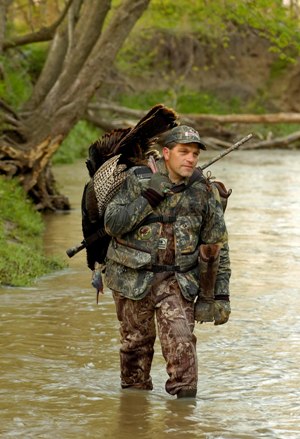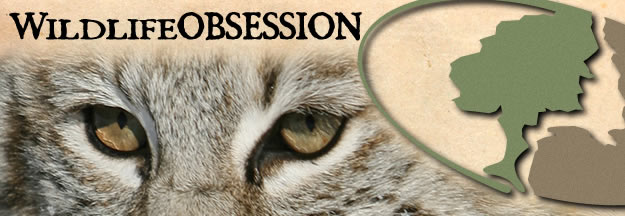
Get Into the Woods Early to Take a Turkey
Editor’s Note: Tracy Groves of Sykesville, Maryland, is the Regional Pro Staff Director for Mossy Oak’s Turkey Division and enjoys hunting public lands. He is a licensed minister and has been the host of the “Real Deal” TV show on the Sportsman’s Channel for 3 years. He recently has developed a camp called Heartwood Outdoors (heartwoodoutdoors.com) to take youngsters from single-parent families hunting, to teach them outdoor skills and to work with special-needs children.
 I like to find the turkeys to hunt on public lands before the season. I go into the woods at first light and get to the highest point I can find. Then I listen for turkeys to gobble and use my compass to determine the direction from which the gobbling is coming. When daylight occurs, and the turkeys shut-up, I walk in the direction where I’ve heard the turkeys gobble and look for the nearest water to that spot. Early in the morning, the first thing a turkey is thinking about is getting a drink of water. Once I find the direction the turkey will be coming from, and I know where the water is, I next attempt to determine the direction I need to come from to get ahead of the turkeys, before they reach the watering hole. Most turkey hunters overlook several steps when they’re scouting by not pinpointing from where the turkey is gobbling, also from what direction the turkey will go once he flies-down from his roost tree and in which direction the hunter needs to move to get ahead of the turkey, once the tom leaves the roost. One of the biggest mistakes most turkey hunters make is they try to get too close to gobblers still on the roost. Too, I look for hunter traffic when scouting, especially after opening weekend. I’ll search for trash they’ve left on the ground.
I like to find the turkeys to hunt on public lands before the season. I go into the woods at first light and get to the highest point I can find. Then I listen for turkeys to gobble and use my compass to determine the direction from which the gobbling is coming. When daylight occurs, and the turkeys shut-up, I walk in the direction where I’ve heard the turkeys gobble and look for the nearest water to that spot. Early in the morning, the first thing a turkey is thinking about is getting a drink of water. Once I find the direction the turkey will be coming from, and I know where the water is, I next attempt to determine the direction I need to come from to get ahead of the turkeys, before they reach the watering hole. Most turkey hunters overlook several steps when they’re scouting by not pinpointing from where the turkey is gobbling, also from what direction the turkey will go once he flies-down from his roost tree and in which direction the hunter needs to move to get ahead of the turkey, once the tom leaves the roost. One of the biggest mistakes most turkey hunters make is they try to get too close to gobblers still on the roost. Too, I look for hunter traffic when scouting, especially after opening weekend. I’ll search for trash they’ve left on the ground.
One other caution is don’t use decoys on public lands. Most turkey hunters don’t have patience, so instead of waiting on a turkey to come to them, they want to try and sneak-up on a gobbler and shoot him. Therefore, if you have a decoy sitting-out in front of you on public land, you may be in harm’s way. For this reason, I don’t use a decoy on public ground. If I’m going to make a mistake on pubic lands, I’m going to make the mistake of being too cautious. I’m in the woods trying to sound like a turkey. I’ve got Mossy Oak camouflage on, so I’m invisible. The very-last thing I want to do is put a decoy out in front of me that looks like a turkey, to give those hunters walking around something at which to shoot. Although I get as far away from other hunters as I can, the reason public lands have their name is because hunters can hunt anywhere they want to on that land. Not all hunters are skilled at looking for a gobbler. So, even if you have a hen decoy in front of you, and there’s a stick in front of that decoy, chest-high, a hunter still may mistake that hen decoy for a gobbler. So, I just don’t use decoys on public land.
Day 3: Transitional Turkey Hunting for More Success
Tomorrow: The 30 Day Option for Taking Turkeys






























